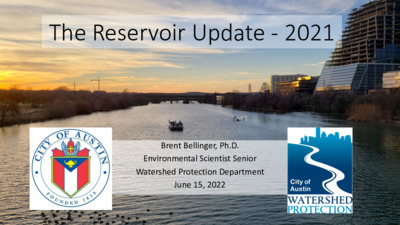20220615-002a: Reservoir Update — original pdf
Backup

The Reservoir Update - 2021 Brent Bellinger, Ph.D. Environmental Scientist Senior Watershed Protection Department June 15, 2022 2021/2022 Projects • On-going Projects • Reservoir monitoring – Austin Lakes Index (ALI) of Lake Austin, Lady Bird Lake, Lake Walter Long • Lake Austin native plant restoration • Collaboration with TPWD fishery monitoring • Zebra Mussel monitoring • Harmful Algal Proliferation (HAP) monitoring • With added sites • New Projects mitigation • Lady Bird nutrient management toward HAP • Collaboration with UT toward sediment bedform mapping and microplastic observations Austin Lakes Index (ALI) Current reservoir condition • Water quality, sediments, aquatic vegetation generally above average • Benthic invertebrates, habitat, eutrophication generally below average ReservoirLake AustinLady Bird LakeWalter E. Long LakeScore020406080100Water qualityBenthic invertebratesAquatic vegetationSediment chemistryHabitat structureEutrophicationOverall scoreExcellentVery goodGoodMarginalPoorBadFair Temporal Trends • Although overall scores appear steady, sub-index components can have large variability Year2010201220142016201820202022Overall lakes Index020406080100Lake AustinLady Bird LakeWalter E. Long LakeExcellentVery goodVery badBadPoorMarginalFairGood2010201220142016201820202022Water quality index405060708090Year2010201220142016201820202022Invertebrate index304050607080 Re-vegetation Efforts • Macrophytes doing well in cages in both reservoirs, thriving outside of cages in LBL • Maintained existing pens in both reservoirs, added new pens to Lake Austin Zebra Mussel Populations • “Ecosystem engineers” that have altered water quality, alter food webs • For example, water clarity correlated with densities L. Austin Flow LBL Year2018201920202021#/m210100100010000Lake AustinLady BirdBig Horn Dr.Kollmeyer Dr.Oppo. CommmonsOppo. Emma LongOpp. MananaRivercrestNalleHoldsworthWalsh#/m21101001000100002018 2019 2020 2021 Red Bud WestMoPac CageRailroad BridgeBoardwalk u. I-35Snake IslandHolly Peninsula#/m2110100100010000 Harmful Algal Proliferations (HAPs) Jessica Hollis Park – 3 positives Emma Long – 0 positives Jessica Hollis Park = 0.06 ± 0.03 mg ATX/kg Walsh Ramp = 1.56 ± 3.03 mg ATX/kg Red Bud – 9 positives Walsh Ramp – 3 positives Red Bud = 0.11 ± 0.13 mg ATX/kg Aud. shores = 0.007 ± 0.013 mg ATX/kg Festival Ramp = 0.002 ± 0.004 mg ATX/kg 19.68 ± 34.53 mg CYN/kg Auditorium Shores – 3 positives Festival Beach – 3 positives Nutrient Mitigation Pilot Project • Background: We are limited in the environmental drivers of HAPs that can be effectively managed • One of the most important drivers is Phosphorus (P) • Hypothesis being tested: Reducing available sediment P will negatively impact HAP growth and toxicity • Sediments of Lady Bird Lake are very P-rich Phoslock • Toward that end, we secured a multi-year contract with SePRO to apply lanthanum- modified bentonite toward sediment P management • Phoslock utilized globally to mitigate excess P that may be released from the sediments • Year 1 – applied 120,000 lbs of Phoslock around Red Bud Isle • For year 2 planning on “maintenance” application around Red Bud, targeting new area Application All 8 Sites West Side (n = 4) East Side (n = 4) Sediment P Results • Across all sites: • 40% decline in P-mobile fraction (good!) • >70% increase in P- immobile (very good!) • Larger changes on west side due to greater content of organic sediments Date6/1/2021 7/1/2021 8/1/2021 9/1/2021 10/1/2021 11/1/2021 % of Total P020406080100Pmobile Pimmobile 6/1/2021 7/1/2021 8/1/2021 9/1/2021 10/1/2021 11/1/2021 6/1/2021 7/1/2021 8/1/2021 9/1/2021 10/1/2021 11/1/2021 Influence on Algal mats and Toxicity? Application Dates 6/21 7/22 8/19 Day160180200220240260280300320ΣATX (mg/kg DW)0.00.10.20.30.40.50.60.7 Sculpture Falls • Samples taken from the popular spot in Barton Creek after a 3-1-1 call of a possible illness • At the time almost no flow, observed algal mats in the pool • Illness not believed to have been cyanotoxin driven; however, we did measure Cylindrospermopsin in the water • Once flows returned to the creek, algae and toxin were not observed • Sculpture falls – Cylindrospermopsin = toxin that impacts liver and kidney (carcinogenic) over long period of drinking water ingestion, or massive ingestion of toxin for acute impact Questions?